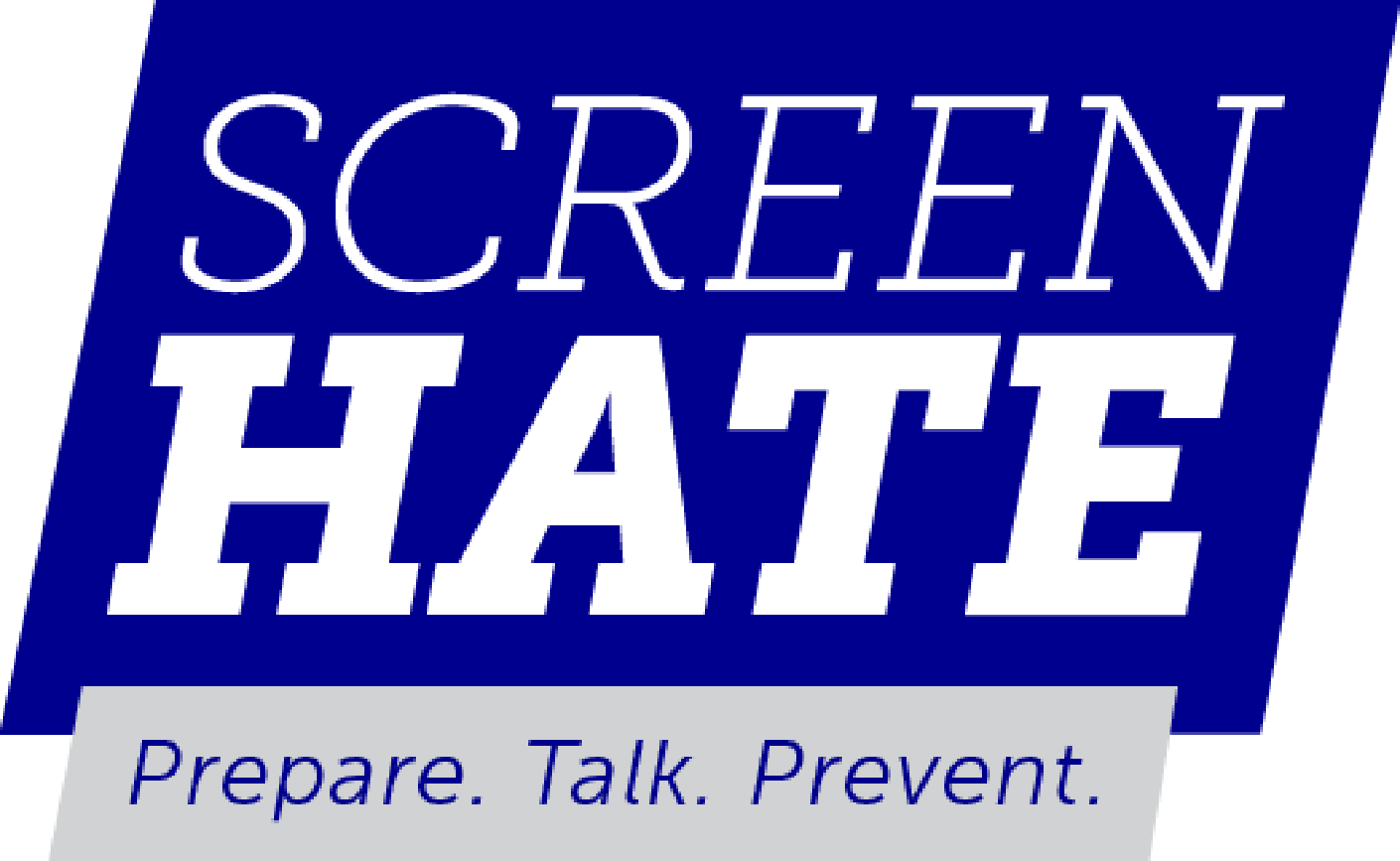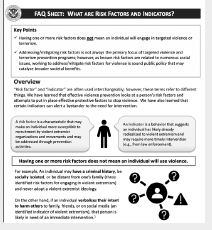Prevent

Adults play a critical role in preventing youth from turning to hate-based violence. Learn more about hate-based violence and how you can help reduce the risk for the teens and young adults in your life.


Warning Signs
What are the warning signs that a young person is being influenced by hate and extremism online?
“Risk factor” and “indicator” are often used interchangeably; however, these terms refer to different things. We have
learned that effective violence prevent looks at a person’s risk factors and attempts to put in place affective
protective factors to stop violence. We have also learned that certain indicators can alert a bystander to the need for
intervention.
A risk factor is a characteristic that may make an individual more susceptible to recruitment by violent extremist organizations and movements may be addressed through presentation activities.
An indicator is a behavior that suggests an individual has likely already radicalized to violent extremism and may require more timely intervention (e.g., from law enforcement).
For example, an individual may have a criminal history, be socially isolated, or be distance from one’s family (three identified risk factors for engaging in violent extremism) and never adopt a violent extremist ideology.
On the other hand, if an individual verbalizes their intent to harm others to family, friends, or on social media (an identified indicator of violent extremism), that person is likely in need of an immediate intervention.

FAQ SHEET: WHAT ARE RISK FACTORS AND INDICATORS?
View & Download
Source:

This toolkit is designed for educators, parents, and families. It provides a helpful explanation of how the changes that take place during adolescence (ages 10-21) make teens and young adults particularly vulnerable to recruitment and how these warning signs manifest. The toolkit provides helpful examples of hate symbols, numeric codes, acronyms, and memes as well as a glossary and resource links.
What’s in this resource?

Youth Risk Factors
Why are young people especially vulnerable to the influence of hate and extremism online?
Adolescents are establishing their own identity and exploring new ways of thinking. Teens often focus on creating an identity separate from their nuclear family, with peer relationships taking center stage. Young people have a heightened desire for belonging and social acceptance, which can make them especially susceptible to both positive and negative peer pressure.
At the same time, adolescents’ cognitive ability to control impulses is still developing. In addition, the part of their brain that perceives rewards from risk is more easily stimulated. This means that teens and young adults may be drawn to risky behaviors.
Desire for social acceptance makes teens more susceptible to the powerful messages of hate and extremism online. They often initially join an extremist community out of a desire for belonging and acceptance and not because they agree with its hateful ideologies. Because hate can often be disguised within humorous or entertaining content, young people may not even realize they are being sucked down an extremist rabbit hole.
Source:
![]() Extreme Measures: How to Help Young People Counter Extremist Recruitment
Extreme Measures: How to Help Young People Counter Extremist Recruitment

This toolkit is designed for educators, parents, and families. It provides a helpful explanation of how the changes that take place during adolescence (ages 10-21) make teens and young adults particularly vulnerable to recruitment and how these warning signs manifest. The toolkit provides helpful examples of hate symbols, numeric codes, acronyms, and memes as well as a glossary and resource links.
What’s in this resource?
What is a risk factor?
A risk factor is a characteristic that may make an individual more susceptible to recruitment by violent extremist organizations and movements and may be addressed through prevention activities.
Overview
“Risk factor” and “indicator” are often used interchangeably; however, these terms refer to different things. We have learned that effective violence prevent looks at a person’s risk factors and attempts to put in place affective protective factors to stop violence. We have also learned that certain indicators can alert a bystander to the need for intervention.
A risk factor is a characteristic that may make an individual more susceptible to recruitment by violent extremist organizations and movements may be addressed through prevention activities.
An indicator is a behavior that suggests an individual has likely already radicalized to violent extremism and may require more timely intervention (e.g., from law enforcement).
For example, an individual may have a criminal history, be socially isolated, or be distance from one’s family (three identified risk factors for engaging in violent extremism) and never adopt a violent extremist ideology.
On the other hand, if an individual verbalizes their intent to harm others to family, friends, or on social media (an identified indicator of violent extremism), that person is likely in need of an immediate intervention.1
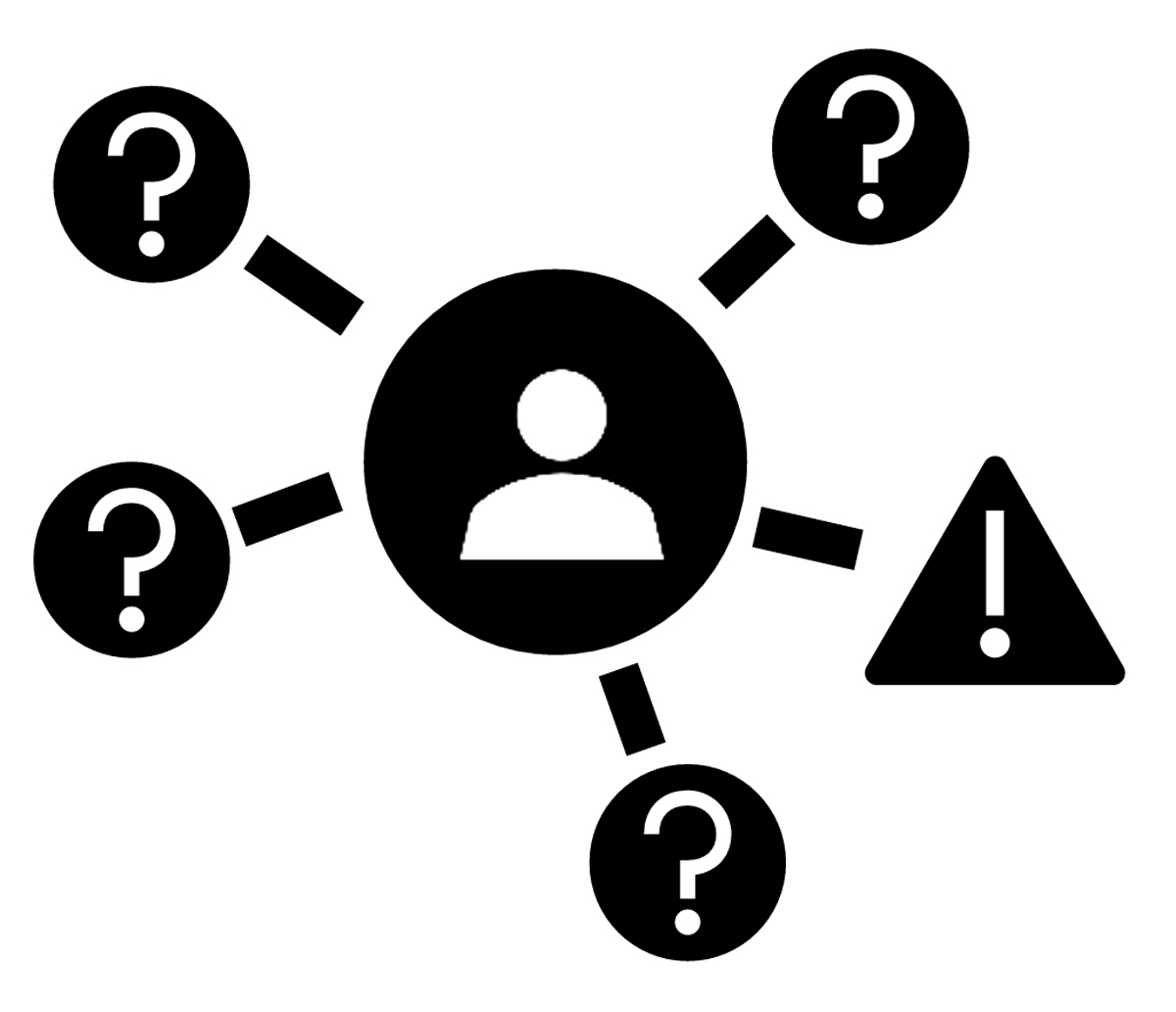
FAQ SHEET: WHAT ARE RISK FACTORS AND INDICATORS?
View & DownloadWhat are the risk factors for young people committing acts of extremist violence?
Disclaimer! Having one or more risk factors does not mean an individual will use violence. A risk factor simply makes a person more vulnerable to adopting false and hateful narratives or beliefs. Most people who hold extremist beliefs never act on them. These risk factors should not be used to predict violent behavior.
Each individual case is different. A holistic approach is needed to consider the totality of concerning behaviors in the appropriate context.
Risk Factors
- Perceived personal or political grievances
- Having an extremist friend
- Psychological issues affecting critical thinking, such as:
- Psychotic disorders like schizophrenia
- Delusional disorder
- Autism spectrum
- Deep commitment to extremist ideology
- Military experience or experience with weaponry
- Criminal history
- Having an enabler
- Problems with:
- Relationships
- Employment
- Traumatic experiences
For more information and research on risk factors and indicators, see:
A teen or young adult I know has several of the listed risk factors. What should I do?
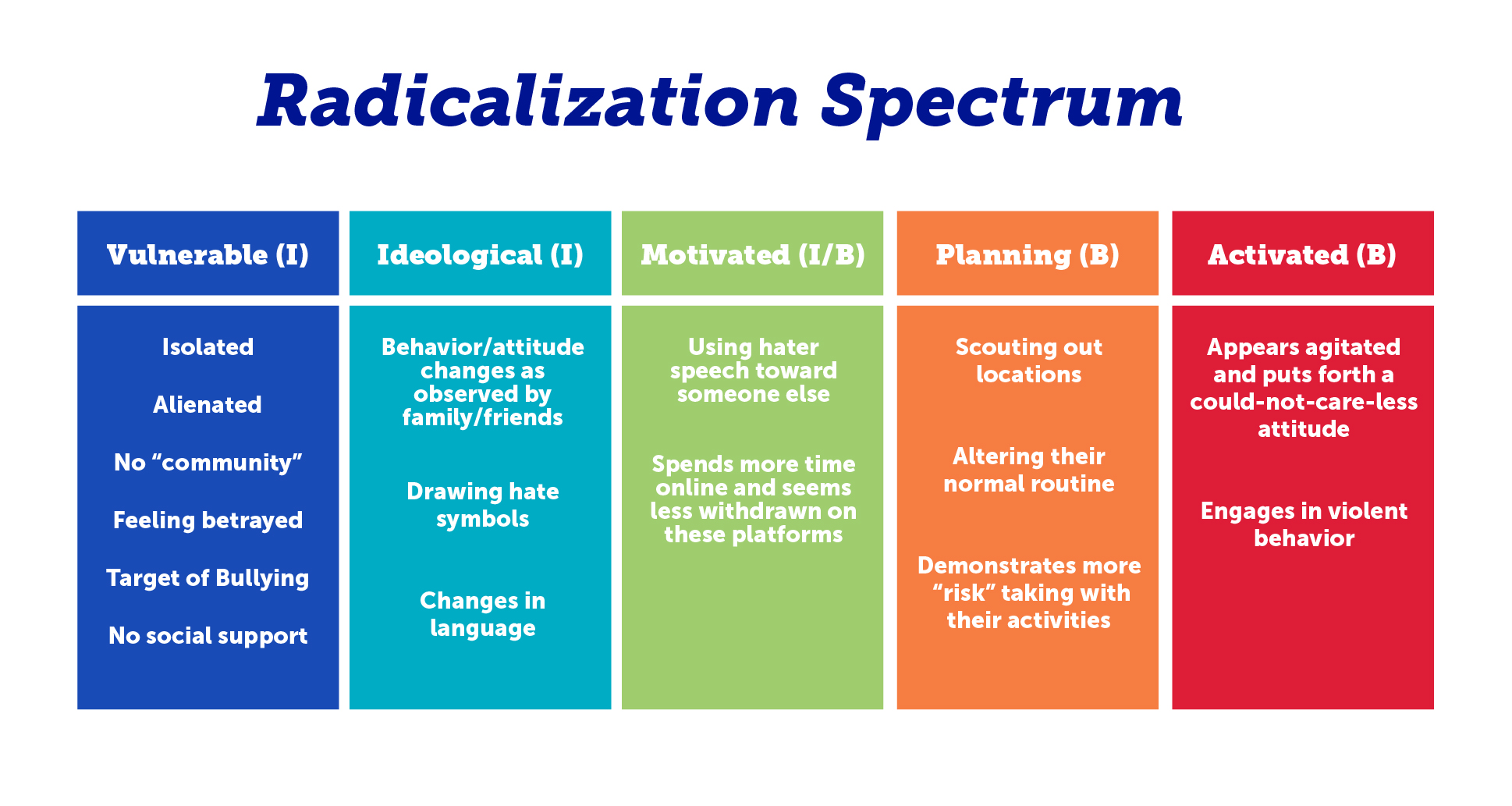
Source:
![]() Extreme Measures: How to Help Young People Counter Extremist Recruitment
Extreme Measures: How to Help Young People Counter Extremist Recruitment

This toolkit is designed for educators, parents, and families. It provides a helpful explanation of how the changes that take place during adolescence (ages 10-21) make teens and young adults particularly vulnerable to recruitment and how these warning signs manifest. The toolkit provides helpful examples of hate symbols, numeric codes, acronyms, and memes as well as a glossary and resource links.
What’s in this resource?
We recommend taking action based on how many risk factors teens are presenting, and to what degree. If you think the person is probably going to hurt themselves, harm other people, or attack a place, that is called “imminent danger.” Call 911 or contact someone in authority immediately like local Safe-to-Tell and Safe-to-Help school hotlines.
Note that many of the risk factors presented above overlap with risk factors for other issues, such as a mental health crisis, general risk of violence or aggression. In any case, it’s best to reach out for help and support as soon as you notice something is “off” with your teen or young adult.
Reach out to someone you trust in your community (for examples, see below) and express your concern. These people will be able to provide a more objective perspective and direct you toward the proper authority.
The key is communicating these observations and information in a timely manner to the proper authorities or a trusted community partner. This helps stop a potential threat before an individual mobilizes to violence.
WHO SHOULD I CONTACT?
Parents, students and educators are encouraged to convey their concerns and observations to trusted community partners, school resource officers or a local law enforcement entity.
| SCHOOLS | COMMUNITY | LAW ENFORCEMENT |
|---|---|---|
| • Teacher | • Hospital | • Local Police Department |
| • Coach | • Doctor | • State Fusion Center |
| • Counselor | • Social Workers | • Country Sheriff |
| • Resource Officer | • Faith-based Leaders | • District Attorney |
| • Principal | • Mental Health Workers | • FBI CVE Program |
| • Parents & Family Members | • State Police |
The key is communicating these observations and information in a timely manner to the proper authorities or a trusted community partner, mitigating a potential threat before an individual mobilizes to violence.
Source:
![]() FBI, Office of Partner Engagement: Preventing Violent Extremism in Schools
FBI, Office of Partner Engagement: Preventing Violent Extremism in Schools

This document serves as a guide to educate school personnel about at-risk behaviors and activities that assist students with reducing social and psychological commitment to violence as a method of resolving a grievance. This guide can be a powerful tool to help empower schools and local communities who play prominent roles in building resilience and providing influence for youth.
What’s in this resource?

Current Extremism Trends
What are the most prevalent extremist ideologies to be on the lookout for right now?
Extremist ideologies are constantly evolving. Among domestic violent extremist movements, the U.S. Department of Homeland Security recently found that “racially and ethnically motivated violent extremists—specifically white supremacist extremists — …[are] the most persistent and lethal threat in the Homeland.” Below are a few of the most active extremist groups in the United States.
• National Socialist Movement – An organization that specializes in theatrical and provocative protests, the National Socialist Movement (NSM) was once one of the largest and most active neo-Nazi groups in the United States.
• The National Alliance – The National Alliance (NA) was for decades the most dangerous and best organized neo-Nazi formation in America. Explicitly genocidal in its ideology, NA materials call for the eradication of the Jews and other races and the creation of an all-white homeland.
• Oath Keepers – The Oath Keepers, which claims tens of thousands of present and former law enforcement officials and military veterans as members, is one of the largest far-right antigovernment groups in the U.S. today.
• Proud Boys – The Proud Boys are self-described “Western chauvinists” who adamantly deny any connection to the racist “alt-right.” They insist they are simply a fraternal group spreading an “anti-political correctness” and “anti-white guilt” agenda.
• Atomwaffen Division – Atomwaffen Division (AWD) is a terroristic neo-Nazi organization that formed out of Iron March, an influential fascist forum that went offline in fall 2017.
• The Base – The Base is an antisemitic, white nationalist network that trains members in survivalism and paramilitary skills to prepare them to mount an armed resistance against the government.
Source:
How do I know if the memes or symbols a teen or young adult is displaying contain hidden hateful messages?
The symbols that represent hateful ideas and hate groups can be cleverly disguised and are constantly evolving. We recommend regularly checking ADL’s Hate Symbols Database to familiarize yourself with the symbols, memes, and related content that are most popular with extremist groups. Below are a few examples.
Symbols
Ok Hand Gestures
Ok Hand Gestures
(general white supremacist hand gesture)
https://www.adl.org/education/referecnes/hate-symbols/okay-hand-gesture
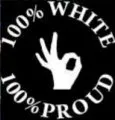
Moon Man
(general white supremacist symbol)
https://www.adl.org/education/referecnes/hate-symbols/moon-man

Numeric Codes
13/52
13/52
Purported percentage of population that is Black vs. purported percentage of murders they commit.
https://www.adl.org/education/referecnes/hate-symbols/1352-1390
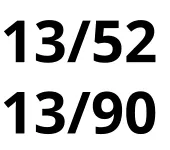
Memes
Many extremist memes are original content, including the messages, artwork and imagery. However, white supremacist extremists will also recognize the popularity of many mainstream memes and then modify and incorporate them into their extremist messaging. This is a strategy that helps to lure targets in. Here are there examples of memes:
“Pepe the Frog” meme


“Smokey the Bear” meme
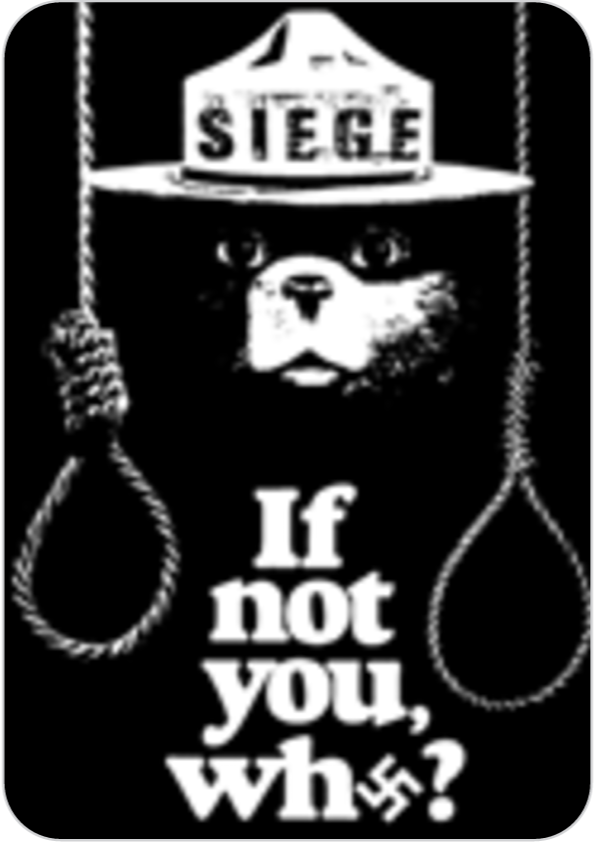

“Keep Calm & Carry On ” meme


The original was a motivational poster produced by the British government in 1939 in preparation for World War II.
Acronyms
White Pride World Wide
https://www.adl.org/education/referecnes/hate-symbols/wpww

This toolkit is designed for educators, parents, and families. It provides a helpful explanation of how the changes that take place during adolescence (ages 10-21) make teens and young adults particularly vulnerable to recruitment and how these warning signs manifest. The toolkit provides helpful examples of hate symbols, numeric codes, acronyms, and memes as well as a glossary and resource links.
White Pride World Wide
https://www.adl.org/education/referecnes/hate-symbols/wpww
Source:
![]() ADL’s Extreme Measures Toolkit
ADL’s Extreme Measures Toolkit

This toolkit is designed for educators, parents, and families. It provides a helpful explanation of how the changes that take place during adolescence (ages 10-21) make teens and young adults particularly vulnerable to recruitment and how these warning signs manifest. The toolkit provides helpful examples of hate symbols, numeric codes, acronyms, and memes as well as a glossary and resource links.
What’s in this resource?
Here are a few resources to compare:
 Signs of hate: Parental guide to far-right codes, symbols, and acronyms
Signs of hate: Parental guide to far-right codes, symbols, and acronyms



How Extremism Operates Online
I know very little about violent extremism. Is it really an issue I should be concerned about? And how do I learn more?
Violent extremists are increasingly using online spaces to spread their messages of hate. At the same time, teens and young adults also spend hours a day online. Young adults’ and teens’ screen media time has increased 17% since March 2020. On average, 90% of teens ages 13 to 17 use social media, and they spend almost nine hours a day online. It is only a matter of time before they encounter hate on their screens.
According to a study conducted by the U.S. Department of Justice, 70% of teens are seeing hate online at least once a week, with more than 33% viewing hate online daily. This widespread hate online has real-world consequences – Six of the nine deadliest mass shootings since 2018 have been carried about by assailants who were 21 years old or younger. In addition, gun violence is the leading cause of death among children.
To learn more about violent extremism online, see our Prepare page and use the resources embedded throughout this Prevent page.
I find the ever-shifting world of social media confusing. How can I help a teen or young adult navigate online hate?
Social media trends evolve rapidly! Teens and young adults are often the most in-tune with online trends. That is why talking to young people about their online lives is so important.
Adults do not need to become experts in social media nor in violent extremist trends in order to help teens and young adults build healthy online habits. Having some baseline knowledge about these topics is helpful, which is why we’ve created SCREEN Hate. At the end of the day, what is most important is that adults help young people to think critically about the people and the content they are engaging with online.
A great way to start is by simply talking with the teen or young adult in your life about these issues. Check out our Talk page for conversation starters and best practices. Start with a conversation about hate online through helpful conversation starters and best practices found on our Talk page.
What does recruitment look like online?
Recruitment hardly ever starts with a stranger randomly messaging your child. Instead, what starts out as liking and sharing memes or comments can turn into social bubbles and rabbit holes of hateful content. Algorithms give users more of what they engage with. Once a teen or young adult becomes curious about groups that spread online hate, extremists offer these teens a sense of community, identity, and belonging.
Most common ways people get radicalized online:
- Content “rabbit holes” (such as through YouTube videos, online chat in video games, etc.)
- Peer sharing
- Social “bubble”
- Direct contact and recruitment from extremists
- Recruiters will encourage people to join encrypted chat rooms, where conversations can’t be tracked by law enforcement or seen publicly on open social media platforms.
Apps and platforms that use high level encryption, hide other apps, and those specifically used to show content that is banned on mainstream internet sites should raise concern, such as:
| Toxic online communities: |
|---|
| 4Chan |
| Gab |
| 8Kun |
| KiwiFarms |
| Incels.com |
| Limited moderation: |
|---|
| Parler |
| Minds |
| BitChute |
| Riot Chat |
| Rocket Chat |
| Odysee/Lbry |
| Highly encrypted: |
|---|
| Telegram |
| Signal |
| Wickr |
| WIRE |
| Proton VPN |
| Protonmail |
| Brave Browser |
Sources:
![]() Building Resilience & Confronting Risk- A Parents & Caregivers Guide to Online Radicalization
Building Resilience & Confronting Risk- A Parents & Caregivers Guide to Online Radicalization

This resource provides an excellent guide to parents and caregivers on how and why online radicalization occurs. It outlines strategies for effectively engaging with young people to stop the process in its tracks and provides a list of resources for seeking help. Finally, the guide provides suggested responses if a child is the victim of online hate or is targeted with harassing content.
What’s in this resource?
![]() FBI, Office of Partner Engagement: Preventing Violent Extremism in Schools
FBI, Office of Partner Engagement: Preventing Violent Extremism in Schools

This document serves as a guide to educate school personnel about at-risk behaviors and activities that assist students with reducing social and psychological commitment to violence as a method of resolving a grievance. This guide can be a powerful tool to help empower schools and local communities who play prominent roles in building resilience and providing influence for youth.
What’s in this resource?

Building Resilience
What is radicalization?
Radicalization is the process by which a person comes to hold extremist beliefs. The process is complex, involving many personal and outside influences, and can take place over long periods of time.
What are ways adults can help youth to build resilience to negative influences online?
Building resilience to online radicalization and other forms of negative influence online follows many of the same guidelines to helping youth build resilience across all areas in life. This includes:
1. Foster critical thinking skills in adolescents.
2. Facilitate discussions with youth about their online lives. Our Talk page includes do’s and don’t’s as well as conversation starters.
3. Provide young people with a safe space where they feel a sense of belonging and acceptance.
4. Encourage youth to get involved in positive communities, such as volunteer work, sports teams, church groups, or other extracurricular activities.
5. Stay informed about the latest social media apps and parental tools. Here is a useful resource guide.
For more details, read:
![]() Building Resilience & Confronting Risk- A Parents & Caregivers Guide to Online Radicalization
Building Resilience & Confronting Risk- A Parents & Caregivers Guide to Online Radicalization

This resource provides an excellent guide to parents and caregivers on how and why online radicalization occurs. It outlines strategies for effectively engaging with young people to stop the process in its tracks and provides a list of resources for seeking help. Finally, the guide provides suggested responses if a child is the victim of online hate or is targeted with harassing content.
What’s in this resource?

Enhancing School Safety
What is a threat assessment?
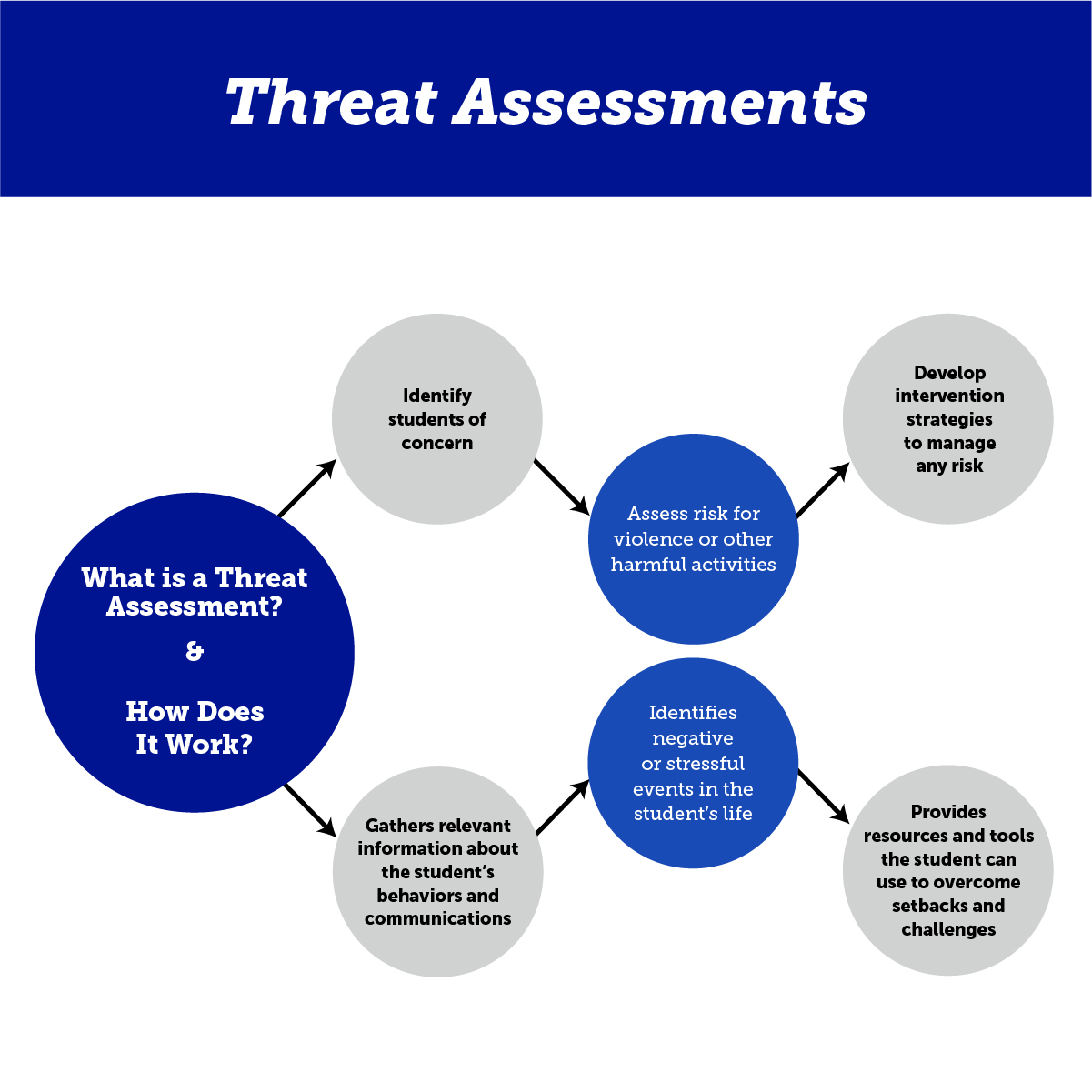
A threat assessment is a process through which school safety officers and counselors identify students who may be at risk of committing acts of violence. It addresses student behavior that is progressing towards violence to themselves and/or others. Some schools may use terms like “behavioral threat assessment” or “safety planning.”
When it comes to school safety, it’s important to note that there is no profile of an attacker. Instead of focusing on a student’s personality or school performance, a threat assessment plots behaviors along a predictable pathway to violence so the right interventions can be used to help the student in crisis and keep others safe.
Source:
![]() Enhancing School Safety Using a Threat Assessment Model
Enhancing School Safety Using a Threat Assessment Model

Developed by the U.S.
Secret Service National Threat Assessment Center (NTAC), this resource outlines the steps for creating a comprehensive targeted violence prevention plan in schools. It also provides additional related resources, such addressing mental health, creating positive school climates, and preventing bullying. This resource outlines actionable, concrete steps that concerned adults at schools can take to prevent violence.
What’s in this resource?
How does it work?
While the term “threat assessment” may sound scary, it is like many other behavioral health assessment processes. Ultimately, a threat assessment helps school staff determine which students may need extra support and develop interventions to help keep everyone safe.
A threat assessment…
- Gathers relevant information about the student’s behaviors and communications. This can include verbal threats, violent social media posts, and physically harming themselves and others.
- Provides resources and tools the student can use to overcome setbacks and challenges
- Identifies negative or stressful events in the student’s life
If a student is found to need support, the threat assessment team will create a tailored intervention plan. The intervention then utilizes community resources to address any underlying issues that may be contributing to a student’s violent extremist beliefs. The plan or “off ramp” may involve mental health evaluations and therapy, connecting them with healthy hobbies and extracurricular activities, social services, job skills counseling, housing support, religious education, or substance abuse counseling.
Source:
![]() Enhancing School Safety Using a Threat Assessment Model
Enhancing School Safety Using a Threat Assessment Model

Developed by the U.S.
Secret Service National Threat Assessment Center (NTAC), this resource outlines the steps for creating a comprehensive targeted violence prevention plan in schools. It also provides additional related resources, such addressing mental health, creating positive school climates, and preventing bullying. This resource outlines actionable, concrete steps that concerned adults at schools can take to prevent violence.
What’s in this resource?
What is a school safety officer?
School safety officers (SSOs) are a police officers who works inside school buildings. Their job is to keep students safe, both from inside disruptions like fights, drugs, and gangs, and from outside intruders.
SSOs have various roles. They…
- Act as first responders in event of an emergency
- Serve as a liaison between police and schools
- Train students on safety issues
Source:
I am a parent. How can I work with educators and school administrators to help support practices for a safe school environment?
We encourage every parent to know the contact information of their student’s school counselor and resource officer. Often times, teens act differently in school than they do at home. For college and university students, this would be their campus safety officer.
Intervention is not a new concept for schools who are already engaged in addressing behavioral issues. Working with your school’s administrators early on can help develop a tailored intervention program to address the needs of your teen or young adult.
Many schools already possess Crisis Response Teams or Behavioral Assessment and Care Teams in place to address any concerning behaviors.
Source:
![]() FBI, Office of Partner Engagement: Preventing Violent Extremism in Schools
FBI, Office of Partner Engagement: Preventing Violent Extremism in Schools

This document serves as a guide to educate school personnel about at-risk behaviors and activities that assist students with reducing social and psychological commitment to violence as a method of resolving a grievance. This guide can be a powerful tool to help empower schools and local communities who play prominent roles in building resilience and providing influence for youth.
What’s in this resource?
I am an educator. Where can I find more info on enhancing school safety?
There are various resources online. We recommend visiting the Schoolsafety.gov website, as well as reading through the three resources below.
Sources:

Developed by the U.S.
Secret Service National Threat Assessment Center (NTAC), this resource outlines the steps for creating a comprehensive targeted violence prevention plan in schools. It also provides additional related resources, such addressing mental health, creating positive school climates, and preventing bullying. This resource outlines actionable, concrete steps that concerned adults at schools can take to prevent violence.
What’s in this resource?
![]() Enhancing School Safety Using a Threat Assessment Model
Enhancing School Safety Using a Threat Assessment Model

Developed by the U.S.
Secret Service National Threat Assessment Center (NTAC), this resource outlines the steps for creating a comprehensive targeted violence prevention plan in schools. It also provides additional related resources, such addressing mental health, creating positive school climates, and preventing bullying. This resource outlines actionable, concrete steps that concerned adults at schools can take to prevent violence.
What’s in this resource?
![]() FBI, Office of Partner Engagement: Preventing Violent Extremism in Schools
FBI, Office of Partner Engagement: Preventing Violent Extremism in Schools

This document serves as a guide to educate school personnel about at-risk behaviors and activities that assist students with reducing social and psychological commitment to violence as a method of resolving a grievance. This guide can be a powerful tool to help empower schools and local communities who play prominent roles in building resilience and providing influence for youth.
What’s in this resource?
![]() Threat Assessment and Reporting – Resources for Schools and Districts
Threat Assessment and Reporting – Resources for Schools and Districts

SchoolSafety.gov developed this one-pager for the K-12 academic community to provide resources and key strategies for identifying and addressing threatening or concerning behaviors before they lead to violence. This is a very useful resource for busy adults and educators who may not have time to read longer, school safety reports
What’s in this resource?

When to Seek Help
A teen or young adult I know has several of the warning signs listed in the “Warning Signs” section above. What should I do next?
If a teen or young adult is exhibiting concern behavior, don’t wait – reach out for help from their school, community, and/or law enforcement.
WHO SHOULD I CONTACT?
Parents, students and educators are encouraged to convey their concerns and observations to trusted community partners, school resource officers or a local law enforcement entity.
| SCHOOLS | COMMUNITY | LAW ENFORCEMENT |
|---|---|---|
| • Teacher | • Hospital | • Local Police Department |
| • Coach | • Doctor | • State Fusion Center |
| • Counselor | • Social Workers | • Country Sheriff |
| • Resource Officer | • Faith-based Leaders | • District Attorney |
| • Principal | • Mental Health Workers | • FBI CVE Program |
| • Parents & Family Members | • State Police |
We recommend taking action based on the number and severity of warning signs teens are presenting. If you believe a person might do something harmful to themselves or others, you should talk to someone you trust and get help to report to law enforcement.
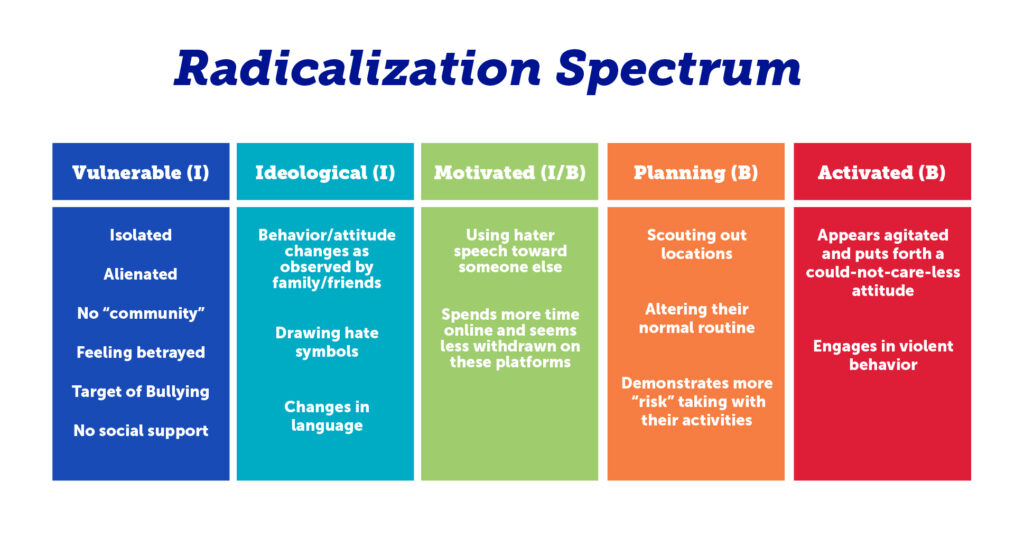
Sources:
![]() FBI, Office of Partner Engagement: Preventing Violent Extremism in Schools
FBI, Office of Partner Engagement: Preventing Violent Extremism in Schools

This document serves as a guide to educate school personnel about at-risk behaviors and activities that assist students with reducing social and psychological commitment to violence as a method of resolving a grievance. This guide can be a powerful tool to help empower schools and local communities who play prominent roles in building resilience and providing influence for youth.
What’s in this resource?

SchoolSafety.gov developed this one-pager for the K-12 academic community to provide resources and key strategies for identifying and addressing threatening or concerning behaviors before they lead to violence. This is a very useful resource for busy adults and educators who may not have time to read longer, school safety reports
What’s in this resource?
A teen or young adult I know is displaying several indicators of planning an attack. What should I do?
Call 911 or your local police department immediately.
I don’t trust law enforcement, but I’m concerned by some behaviors that a teen or young adult is displaying. Who else can I turn to?
People from marginalized communities and/or communities of color may, understandably, feel reluctant to turn to law enforcement. If a teen or young adult is in imminent danger of carrying out an attack, contacting law enforcement is the most effective way to keep community members safe.
If the teen or young adult is not in imminent danger, there are plenty of other community members to whom you could turn for help. We recommend promptly seeking help from any one of the individuals below, ideally someone whom you trust and who knows the teen or young adult well. Staff at schools, universities, medical facilities, and community organizations are usually trained in crisis intervention and can assist young people in getting the help they need.
WHO SHOULD I CONTACT?
Parents, students and educators are encouraged to convey their concerns and observations to trusted community partners, school resource officers or a local law enforcement entity.
| SCHOOLS | COMMUNITY | LAW ENFORCEMENT |
|---|---|---|
| • Teacher | • Hospital | • Local Police Department |
| • Coach | • Doctor | • State Fusion Center |
| • Counselor | • Social Workers | • Country Sheriff |
| • Resource Officer | • Faith-based Leaders | • District Attorney |
| • Principal | • Mental Health Workers | • FBI CVE Program |
| • Parents & Family Members | • State Police |
Source:
![]() FBI, Office of Partner Engagement: Preventing Violent Extremism in Schools
FBI, Office of Partner Engagement: Preventing Violent Extremism in Schools

This document serves as a guide to educate school personnel about at-risk behaviors and activities that assist students with reducing social and psychological commitment to violence as a method of resolving a grievance. This guide can be a powerful tool to help empower schools and local communities who play prominent roles in building resilience and providing influence for youth.
What’s in this resource?
I’m worried about the repercussions of reporting a teen. What if they get in trouble? What if I’m wrong about the warning signs?
While choosing to report a loved one or someone you know may be a scary decision, it can save someone’s life – including their own. Each situation is different. If a teen or young adult has committed a crime or violated school rules, they may face consequences. But they might also get help and avoid facing more serious consequences.
You are most likely concerned for a valid reason, and the person you know or love needs help and support. Whether you voice your concern anonymously or not, you are helping this person get the support they need. This can range from mental health support, counseling and mentoring to the confiscation of deadly firearms and psychological evaluation.This is when professional teams help the person and work to keep the community safe at the same time.
The best thing you can do is voice your concern to someone you trust. Then find someone who can help. Most often, this is a school or campus safety officer, counselor, or local police officer. Do not worry alone and do not wait until it’s too late.
Here’s a curated list of resources that can help.
click ![]() to learn more about each resource below.
to learn more about each resource below.
Building Resilience & Confronting Risk – A Parents & Caregivers Guide to Online Radicalization

This resource provides an excellent guide to parents and caregivers on how and why online radicalization occurs. It outlines strategies for effectively engaging with young people to stop the process in its tracks and provides a list of resources for seeking help. Finally, the guide provides suggested responses if a child is the victim of online hate or is targeted with harassing content.
This resource provides an excellent guide to parents and caregivers on how and why online radicalization occurs. It outlines strategies for effectively engaging with young people to stop the process in its tracks and provides a list of resources for seeking help. Finally, the guide provides suggested responses if a child is the victim of online hate or is targeted with harassing content.
(Polarization & Extremism Research & Innovation Lab (PERIL) and Southern Poverty Law Center (SPLC))
Extreme Measures – How to Help Young People Counter Extremist Recruitment Toolkit

This toolkit is designed for educators, parents, and families. It provides a helpful explanation of how the changes that take place during adolescence (ages 10-21) make teens and young adults particularly vulnerable to recruitment and how these warning signs manifest. The toolkit provides helpful examples of hate symbols, numeric codes, acronyms, and memes as well as a glossary and resource links.
This toolkit is designed for educators, parents, and families. It provides a helpful explanation of how the changes that take place during adolescence (ages 10-21) make teens and young adults particularly vulnerable to recruitment and how these warning signs manifest. The toolkit provides helpful examples of hate symbols, numeric codes, acronyms, and memes as well as a glossary and resource links.
(Anti-Defamation League (ADL) Education)
Enhancing School Safety Using A Threat Assessment Model

Developed by the U.S.
Secret Service National Threat Assessment Center (NTAC), this resource outlines the steps for creating a comprehensive targeted violence prevention plan in schools. It also provides additional related resources, such addressing mental health, creating positive school climates, and preventing bullying. This resource outlines actionable, concrete steps that concerned adults at schools can take to prevent violence
Developed by the U.S.
Secret Service National Threat Assessment Center (NTAC), this resource outlines the steps for creating a comprehensive targeted violence prevention plan in schools. It also provides additional related resources, such addressing mental health, creating positive school climates, and preventing bullying. This resource outlines actionable, concrete steps that concerned adults at schools can take to prevent violence
(An Operation Guide for Preventing Targeted School Violence)
Threat Assessment and Reporting – Resources for Schools and Districts

SchoolSafety.gov
developed this one-pager for the K-12 academic community to provide resources and key strategies for identifying and addressing threatening or concerning behaviors before they lead to violence. This is a very useful resource for busy adults and educators who may not have time to read longer, school safety reports
SchoolSafety.gov
developed this one-pager for the K-12 academic community to provide resources and key strategies for identifying and addressing threatening or concerning behaviors before they lead to violence. This is a very useful resource for busy adults and educators who may not have time to read longer, school safety reports
An Operation Guide for Preventing Targeted School Violence
#ThinkBeforeSharing – Stop the spread of conspiracy theories

This UNESCO webpage addresses conspiracy theories and features downloadable infographics and social media packs in multiple languages. The resources cover topics such as the danger of conspiracy theories, how they are linked to anti-Semitism, how to debunk them, and how to talk to someone who believes in them. We chose to feature this site because its resources are visually engaging and could easily be used by parents and educators to discuss conspiracy theories and the spread of hate with teens and young adults.
This UNESCO webpage addresses conspiracy theories and features downloadable infographics and social media packs in multiple languages. The resources cover topics such as the danger of conspiracy theories, how they are linked to anti-Semitism, how to debunk them, and how to talk to someone who believes in them. We chose to feature this site because its resources are visually engaging and could easily be used by parents and educators to discuss conspiracy theories and the spread of hate with teens and young adults.
(UNESCO)
Where Kids Find Hate Online

Common Sense Media is a leading source of entertainment and technology recommendations for families and schools. This short article discusses how kids are exposed to hate online, the internet’s role in spreading hate speech and false information, and the legal and ethical debates around Constitutionally protected free speech. The excellent conversation starters around hate speech, hate crimes, and the role and responsibility of technology companies are a good complement to our existing conversation starters on our “Talk” page.
Common Sense Media is a leading source of entertainment and technology recommendations for families and schools. This short article discusses how kids are exposed to hate online, the internet’s role in spreading hate speech and false information, and the legal and ethical debates around Constitutionally protected free speech. The excellent conversation starters around hate speech, hate crimes, and the role and responsibility of technology companies are a good complement to our existing conversation starters on our “Talk” page.
(Common Sense Media)
Hate on Display™ Hate Symbols Database

ADL’s “Hate on Display” database provides a robust repository of 214 hate symbols that are searchable by keywords and filters. Parents and concerned adults can use this to educate themselves on symbols that would be a warning sign if they see teens or young adults displaying them.
ADL’s “Hate on Display” database provides a robust repository of 214 hate symbols that are searchable by keywords and filters. Parents and concerned adults can use this to educate themselves on symbols that would be a warning sign if they see teens or young adults displaying them.
(Anti-Defamation League)
White Supremacy Search Trends in the United States

This report provides an overview of online white supremacist narrative trends in 2020 and 2021. In-depth data explores the terms and online spaces people used to search for extremist content, the most popular types of extremist literature and merchandise, and search trends by geographic locations and demographics. Use this resource to learn more about where and how teens and young adults may be searching for extremist content online.
This report provides an overview of online white supremacist narrative trends in 2020 and 2021. In-depth data explores the terms and online spaces people used to search for extremist content, the most popular types of extremist literature and merchandise, and search trends by geographic locations and demographics. Use this resource to learn more about where and how teens and young adults may be searching for extremist content online.
(Moonshot & ADL)
Domestic Violent Extremist Mobilization in the United States

This web page provides state-level infographics that cover data collected on Google Search from September 2020 until March 2021 related to Domestic Violent Extremist mobilizations to targeted violence, political violence, conspiracy theories, and armed groups. Concerned adults can learn more about trends in their specific state.
This web page provides state-level infographics that cover data collected on Google Search from September 2020 until March 2021 related to Domestic Violent Extremist mobilizations to targeted violence, political violence, conspiracy theories, and armed groups. Concerned adults can learn more about trends in their specific state.
(Moonshot)
The Threat Landscape: White Supremacy and Anti-Government Violence

This prevention and intervention practice guide was developed by the McCain Institute’s Prevention Practitioners Network to provide to practitioners an overview of white supremacy and anti-government violence in the United States. It includes blurbs on social media platforms that have been used for recruitment into these movements that complements our “Prepare” page.
This prevention and intervention practice guide was developed by the McCain Institute’s Prevention Practitioners Network to provide to practitioners an overview of white supremacy and anti-government violence in the United States. It includes blurbs on social media platforms that have been used for recruitment into these movements that complements our “Prepare” page.
(US Prevention Practitioners Network)
How Extremism Operates Online

This research study is a primer on online extremism. It explains and defines common terminology, how extremist groups operate and use the internet, as well as ways that people can counter these violent extremists and hateful content online.
This research study is a primer on online extremism. It explains and defines common terminology, how extremist groups operate and use the internet, as well as ways that people can counter these violent extremists and hateful content online.
(RAND Corporation)
Office of Partner Engagement: Preventing Violent Extremism in Schools

This document serves as a guide to educate school personnel about at-risk behaviors and activities that assist students with reducing social and psychological commitment to violence as a method of resolving a grievance. This guide can be a powerful tool to help empower schools and local communities who play prominent roles in building resilience and providing influence for youth.
This document serves as a guide to educate school personnel about at-risk behaviors and activities that assist students with reducing social and psychological commitment to violence as a method of resolving a grievance. This guide can be a powerful tool to help empower schools and local communities who play prominent roles in building resilience and providing influence for youth.
(FBI)
Keeping Up with Apps and Parental Tools: Resource and Guide Packet

This document helps
parents and caregivers step-by-step instructions to understand where particular settings – both parental and privacy – are available and what features they include. It also provides video tutorials on how to enable them on each platform.
This document helps
parents and caregivers step-by-step instructions to understand where particular settings – both parental and privacy – are available and what features they include. It also provides video tutorials on how to enable them on each platform.
(No More Stolen Childhoods)

Do you find this information helpful?
